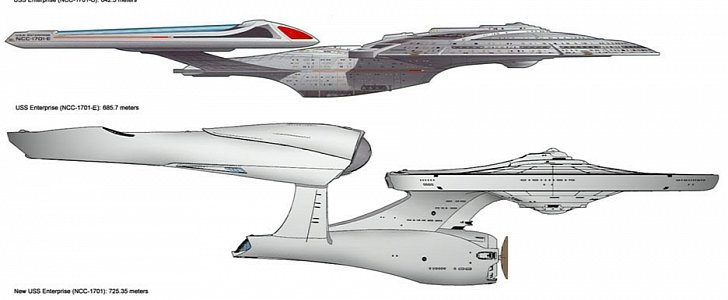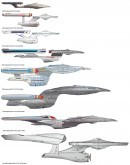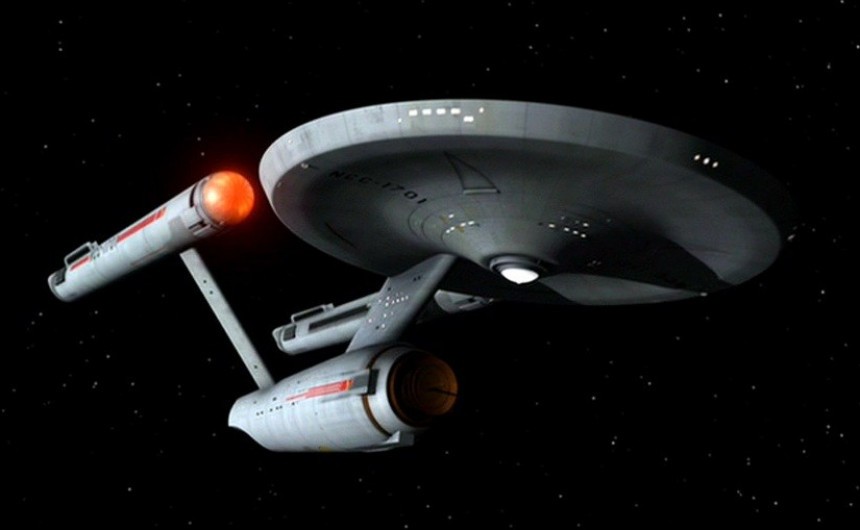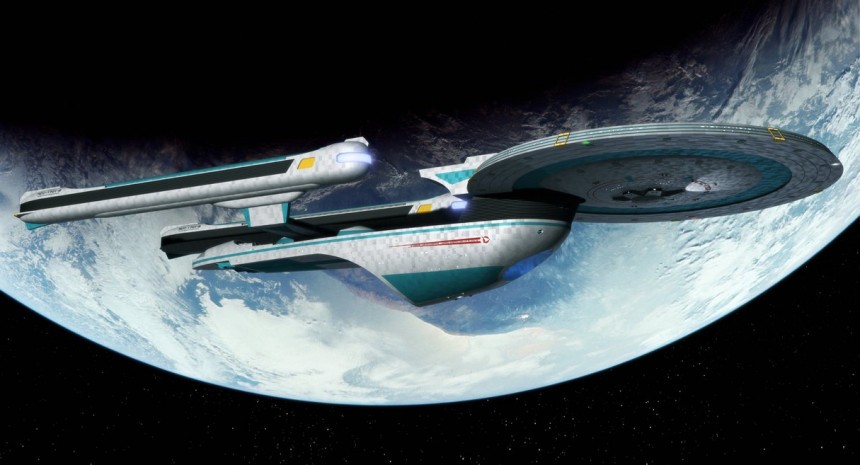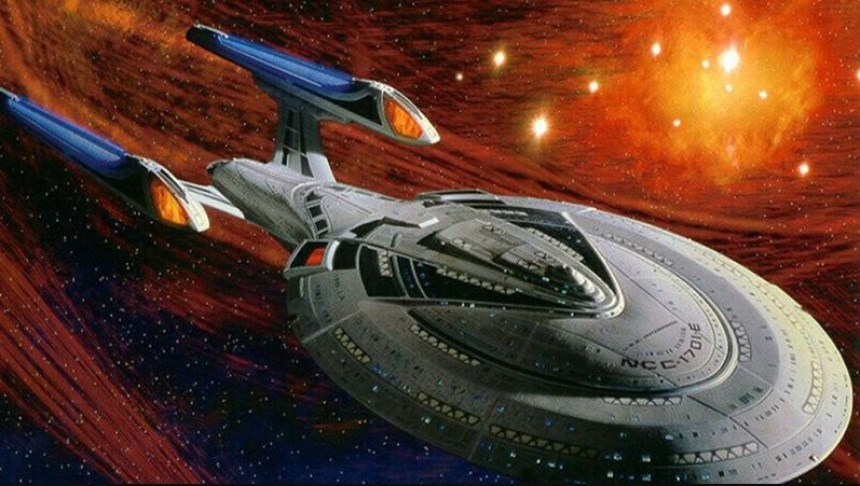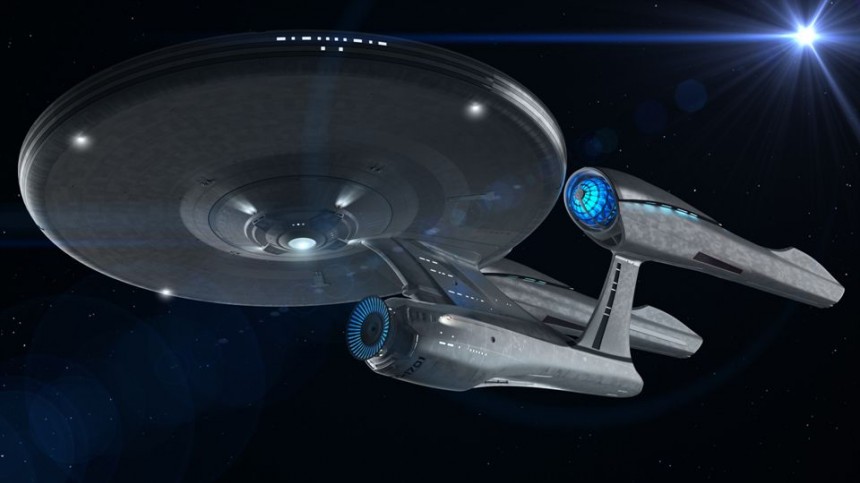Star Trek, the most complex, thrilling and innovative franchise ever created (sorry, Star Wars fans). Underlined with political or philosophical messages, funny and action-packed, it features solid acting, well-written stories and dialog, and the most recognizable spaceship in both real life and on-screen: the USS Enterprise.
“Space: the final frontier. These are the voyages of the starship Enterprise. Its five-year mission: to explore strange new worlds, to seek out new life and new civilizations, to boldly go where no man has gone before.”
This is the iconic opening of the original Star Trek series from 1966, documenting the adventures of one Captain James T. Kirk (William Shatner) and his crew on board the Enterprise. Much like the ship itself, it’s immediately recognizable. Both the Enterprise and the franchise built around it have come to represent sci-fiction at its best: the kind that encourages man to better himself, to question himself, to do away with his prejudices, to push himself to new limits.
The Star Trek franchise includes, so far, several crews, 5 live-action series, an animated series, several films with the original cast and a reboot, novelizations and comics. It created an obsessive fandom and prompted an ongoing conversation on the power of storytelling to change our very-real life and even, to a certain extent, predict the future.
What ties all this together is USS Enterprise, the ship that makes that “boldly go where no man has gone before” possible. So let’s have a look at its various iterations, to see how it evolved with the times.
The first ship commissioned by the United Federation of Planets for deep-space exploration is NX-01, which was operational between 2151 and 2161. It’s an NX Class, a prototype ship designed with exploration in mind. Commanded by Captain Jonathan Archer, it can reach a maximum speed of Warp 5 and accommodate a crew of 83. It was featured in the prequel TV series Star Trek: Enterprise (2001-2005).
It is the first to feature a design that would become iconic with the next iterations: a disc-shaped hull and two nacelles housing the propulsion system.
The Enterprise featured in the original Star Trek series (1966-1969) is an upgrade to that first vessel. NCC-1701 was in use between 2245 and 2270, and is a Constitution Class ship commanded by Captain James T. Kirk (Shatner), he of the womanizing ways and mean drop-kicks. It can fit a crew of 500 and formalizes the now-iconic Enterprise design: the saucer, the engine nacelles and the cylindrical secondary hull that’s the body of the ship.
As Star Trek crossed over from television to cinematography, designers went back to the board and redesigned the ship, retrofitting it with upgrades. The result, NCC-1701 Refit is more dynamic and has dual extra vehicular activity bays for maintenance and easier access for cargo ships.
NCC-1701 Refit is still a Constitution Class ship, measuring 305 meters in length. It went on its maiden journey in 2270 and was featured in 3 films, Star Trek: The Motion Picture (1979), Star Trek II: The Wrath of Khan (1982), and Star Trek III: The Search for Spock (1984). It was destroyed at the end of The Search for Spock after an encounter with the Klingons.
Star Trek IV: The Voyage Home (1986) sees the crew on another Enterprise, only that, this time, it’s not new. The Federation commissions an old Constitution Class ship and renames it USS Enterprise. Registry NCC-1701-A was operational between 2286 and 2293, and appeared in the 1986 film and in subsequent movies featuring the original crew.
In Star Trek: Generations, an upgraded model shows up: the year is now 2293, and NCC-1701-B, an Excelsior Class, is longer (455.8 meters) and has a more compact design with a stronger neck between saucer and the body of the ship. It was decommissioned after it was struck by the tendrils of an “energy ribbon” in Generations, under the command of now-Admiral Kirk.
Ambassador Class NCC-1701-C is a 38-deck ship with a very short lifespan. It was only featured in a Next Generation episode (Yesterday’s Enterprise, 1990) and was destroyed in 2344 in a Romulan battle, under the command of Captain Rachel Garrett.
The next iteration of the Enterprise really brings the wow factor: NCC-1701-D is now a Galaxy Class, the largest ever in Starship. With a crew of 1,016, it also carries scientists and civilians, and is designed with a focus on communities and not necessarily on war functionality. It’s fitted for conflict, too.
For instance, the new design includes strips on the hull that allow the phasers to move independently towards different targets. It also has 2 photon torpedo bays that can fire 10 torpedoes simultaneously, and each can be given a separate target. With a max warp speed of 9.6 (which it can sustain for 12 consecutive hours), it’s commanded by Captain Jean-Luc Picard (Patrick Stewart) and provides the main setting for Star Trek: The Next Generation TV series (1987-1994).
NCC-1701-D was operational between 2363 and 2371, and was destroyed in Star Trek: Generations, after a battle with the Klingons, in which it sustained so much damage as to become unrecoverable. Picard decided to detach the saucer from the body of the ship, crashing the saucer to save the crew.
The next iteration is NCC-1701-E, a Sovereign Class, in 2372. With a maximum warp speed of 9.985, it is larger and more tactically capable, and sleeker as it’s envisioned as a battleship. It’s twice as long as the D but has a much tighter design, with a shorter neck between saucer and body.
Created to fight the Borg, the E is fitted with quantum torpedoes that use zero-point energy, which increases their destructive power by a factor of 2.5 as compared to a standard torpedo. Commanded by Picard, it was the setting for Star Trek: First Contact (1996), Star Trek: Insurrection (1998) and Star Trek Nemesis (2002), and was retired after it took substantial damage at the end of Nemesis after colliding with an enemy ship.
The rebooted Star Trek brings back the NCC-1701, but this time, it's bigger and more powerful than ever. The films are set in an alternate universe, making it possible for the original characters to return, so Captain Kirk (Chris Pine) is back at the commands. It appears in Star Trek (2009), Star Trek Into Darkness (2013) and Star Trek Beyond (2016), and is destroyed at the end of the 2016 film.
Star Trek Beyond sees the crew go back into space on USS Enterprise registry NCC-1701-A, a Constitution Class. The year is again 2263 and we have come full circle.
To a non-Trekkie, it might seem silly to dedicate this much time and virtual ink to a fictional spaceship, but that would mean denying what an important part it played in sci-fi – and storytelling, in general.
As astrophysicist Neil DeGrasse Tyson put it in a 2015 National Geographic discussion on Star Trek:
“What matters is not what they look like now, but what they looked to others at the time that they prevailed... There is only one spaceship that's earlier than [the original Enterprise], and that's the flying saucer from The Day the Earth Stood Still. So, what matters here is, what did [the Enterprise] look like at the time it came out (1966) compared with anything that had been imagined before? And when you consider that, that is the most astonishing machine that has ever graced the screen.”
At the time the Enterprise first appeared on the small screen, it was the only spaceship designed for exploration and not transportation. “It was revolutionary in terms of what we would think space would, and should, be about,” DeGrasse says.
Ultimately, USS Enterprise is revolutionary because it represents humanity’s ability to dream – and to pursue those dreams relentlessly.
This is the iconic opening of the original Star Trek series from 1966, documenting the adventures of one Captain James T. Kirk (William Shatner) and his crew on board the Enterprise. Much like the ship itself, it’s immediately recognizable. Both the Enterprise and the franchise built around it have come to represent sci-fiction at its best: the kind that encourages man to better himself, to question himself, to do away with his prejudices, to push himself to new limits.
The Star Trek franchise includes, so far, several crews, 5 live-action series, an animated series, several films with the original cast and a reboot, novelizations and comics. It created an obsessive fandom and prompted an ongoing conversation on the power of storytelling to change our very-real life and even, to a certain extent, predict the future.
What ties all this together is USS Enterprise, the ship that makes that “boldly go where no man has gone before” possible. So let’s have a look at its various iterations, to see how it evolved with the times.
The first ship commissioned by the United Federation of Planets for deep-space exploration is NX-01, which was operational between 2151 and 2161. It’s an NX Class, a prototype ship designed with exploration in mind. Commanded by Captain Jonathan Archer, it can reach a maximum speed of Warp 5 and accommodate a crew of 83. It was featured in the prequel TV series Star Trek: Enterprise (2001-2005).
It is the first to feature a design that would become iconic with the next iterations: a disc-shaped hull and two nacelles housing the propulsion system.
The Enterprise featured in the original Star Trek series (1966-1969) is an upgrade to that first vessel. NCC-1701 was in use between 2245 and 2270, and is a Constitution Class ship commanded by Captain James T. Kirk (Shatner), he of the womanizing ways and mean drop-kicks. It can fit a crew of 500 and formalizes the now-iconic Enterprise design: the saucer, the engine nacelles and the cylindrical secondary hull that’s the body of the ship.
NCC-1701 Refit is still a Constitution Class ship, measuring 305 meters in length. It went on its maiden journey in 2270 and was featured in 3 films, Star Trek: The Motion Picture (1979), Star Trek II: The Wrath of Khan (1982), and Star Trek III: The Search for Spock (1984). It was destroyed at the end of The Search for Spock after an encounter with the Klingons.
Star Trek IV: The Voyage Home (1986) sees the crew on another Enterprise, only that, this time, it’s not new. The Federation commissions an old Constitution Class ship and renames it USS Enterprise. Registry NCC-1701-A was operational between 2286 and 2293, and appeared in the 1986 film and in subsequent movies featuring the original crew.
Ambassador Class NCC-1701-C is a 38-deck ship with a very short lifespan. It was only featured in a Next Generation episode (Yesterday’s Enterprise, 1990) and was destroyed in 2344 in a Romulan battle, under the command of Captain Rachel Garrett.
The next iteration of the Enterprise really brings the wow factor: NCC-1701-D is now a Galaxy Class, the largest ever in Starship. With a crew of 1,016, it also carries scientists and civilians, and is designed with a focus on communities and not necessarily on war functionality. It’s fitted for conflict, too.
For instance, the new design includes strips on the hull that allow the phasers to move independently towards different targets. It also has 2 photon torpedo bays that can fire 10 torpedoes simultaneously, and each can be given a separate target. With a max warp speed of 9.6 (which it can sustain for 12 consecutive hours), it’s commanded by Captain Jean-Luc Picard (Patrick Stewart) and provides the main setting for Star Trek: The Next Generation TV series (1987-1994).
NCC-1701-D was operational between 2363 and 2371, and was destroyed in Star Trek: Generations, after a battle with the Klingons, in which it sustained so much damage as to become unrecoverable. Picard decided to detach the saucer from the body of the ship, crashing the saucer to save the crew.
Created to fight the Borg, the E is fitted with quantum torpedoes that use zero-point energy, which increases their destructive power by a factor of 2.5 as compared to a standard torpedo. Commanded by Picard, it was the setting for Star Trek: First Contact (1996), Star Trek: Insurrection (1998) and Star Trek Nemesis (2002), and was retired after it took substantial damage at the end of Nemesis after colliding with an enemy ship.
The rebooted Star Trek brings back the NCC-1701, but this time, it's bigger and more powerful than ever. The films are set in an alternate universe, making it possible for the original characters to return, so Captain Kirk (Chris Pine) is back at the commands. It appears in Star Trek (2009), Star Trek Into Darkness (2013) and Star Trek Beyond (2016), and is destroyed at the end of the 2016 film.
To a non-Trekkie, it might seem silly to dedicate this much time and virtual ink to a fictional spaceship, but that would mean denying what an important part it played in sci-fi – and storytelling, in general.
As astrophysicist Neil DeGrasse Tyson put it in a 2015 National Geographic discussion on Star Trek:
“What matters is not what they look like now, but what they looked to others at the time that they prevailed... There is only one spaceship that's earlier than [the original Enterprise], and that's the flying saucer from The Day the Earth Stood Still. So, what matters here is, what did [the Enterprise] look like at the time it came out (1966) compared with anything that had been imagined before? And when you consider that, that is the most astonishing machine that has ever graced the screen.”
At the time the Enterprise first appeared on the small screen, it was the only spaceship designed for exploration and not transportation. “It was revolutionary in terms of what we would think space would, and should, be about,” DeGrasse says.
Ultimately, USS Enterprise is revolutionary because it represents humanity’s ability to dream – and to pursue those dreams relentlessly.
